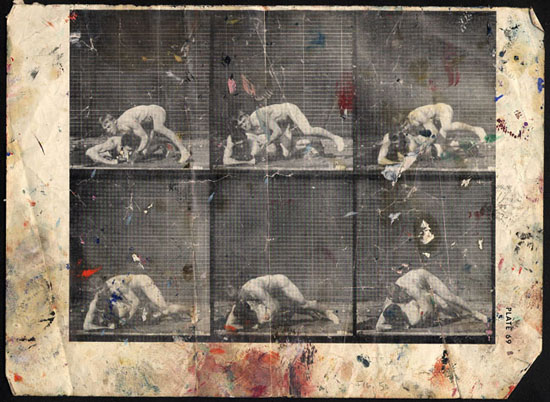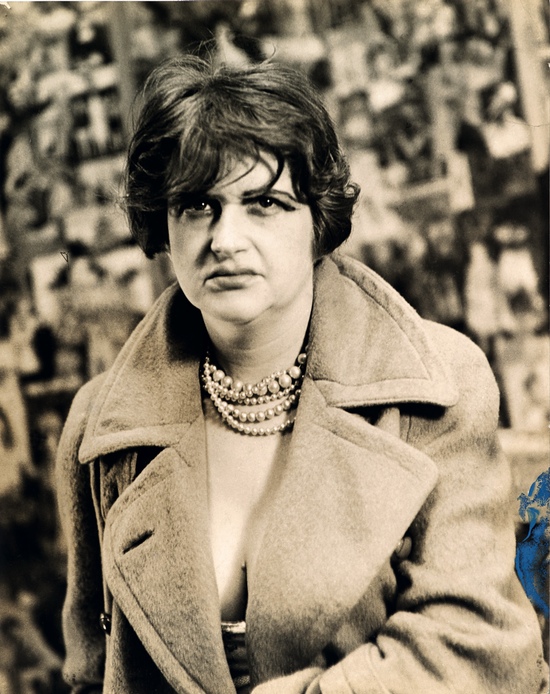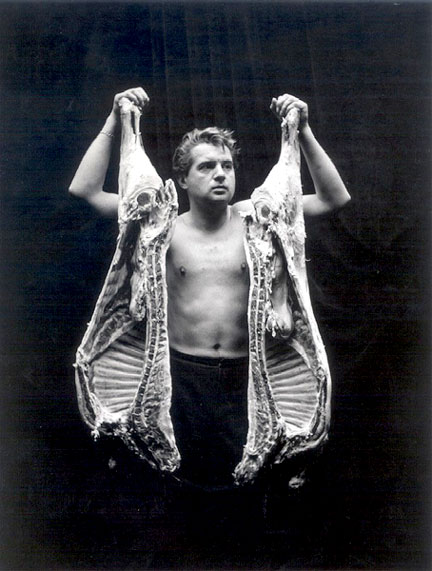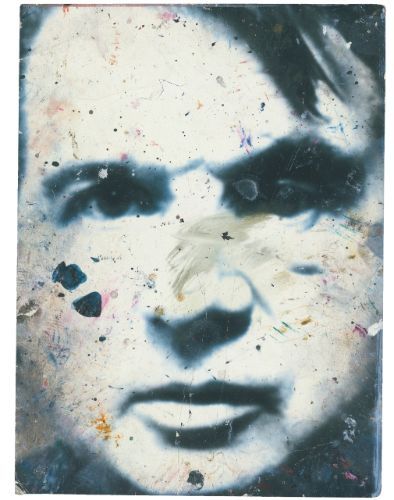
Portrait of Francis Bacon, photographer Unknown. Found in Bacon’s 7 Reece Mews studio. 1972 / (c) Estate of Francis Bacon
During a visit to Ireland a few years ago, I went to an exhibition on Francis Bacon and the fascinating contents of his chaotic London studio. After the painter’s death, everything in his famed 7 Reece Mews studio was left untouched for years and eventually all donated to Dublin’s Hugh Lane Gallery. Paint brushes, canvases, documents, photographs, were all carefully cataloged and moved to Dublin for the eventual reconstruction of the space in Dublin. And the Hugh Lane really did put together something special, I imagined it would be his studio space with the original contents and a few supporting documents, but with all that was made accessible, it turned out to be one of the best exhibits I’ve been to in a long time.
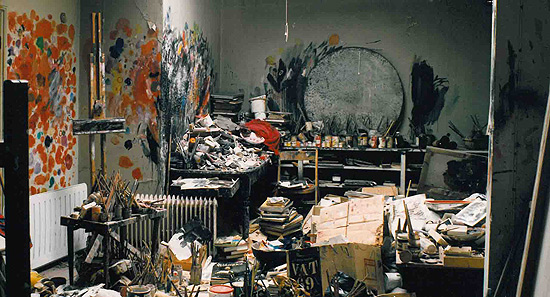
The 7 Reece Mews Studio
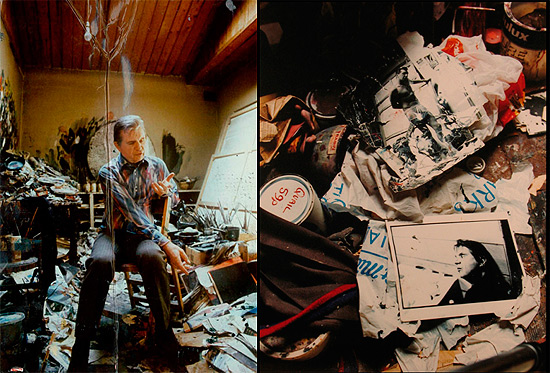
L: Bacon in his studio – R: Studio detail showing a portrait of Bacon and an image of Mohamed Ali
Thousands of photographic prints, magazine reproductions, scientific manuals, were found littered around his London studio, ranging from images of Mohamed Ali & Marylyn Monroe, to studies of human and animal movement, war imagery, and reproductions of work by classic painters such as Velasquez and Rembrandt. Most of the images were creased, crumpled even torn and paint stained. I knew Bacon had used some photography as inspiration, but had no idea it was to that extent… A vast database of all these pictures was accessible via touch screens on the gallery’s walls, including information on how they influenced his work, a unique insight into Bacon’s approach to painting, a man who was never filmed or closely watched while painting. The database featured images that influenced his paintings, passport pictures, even holiday snaps, and countless portraits of himself by famed photographers such as Henri Cartier Bresson, all paint stained and creased, sometimes torn, and put back together… Discovering this side of Bacon was like discovering a new artist, I stayed there for ages searching through all the documents available, fascinating.
Eadweard Muybridge’s work (above), heavily influenced the way Bacon expressed the human body’s movements. The pioneering photographer developed a multiple camera system in the 1870s to record movement sequences first of animals and humans. A whole room full of paint stained, torn and crumpled reproductions of Muybridge’s work, originally found in Bacon’s London studio was on display at the gallery. Bacon would often go to the Victoria & Albert museum, just round the corner form his studio, where all the original plates were kept, he later acquired reproductions and used them extensively for core elements of his paintings.
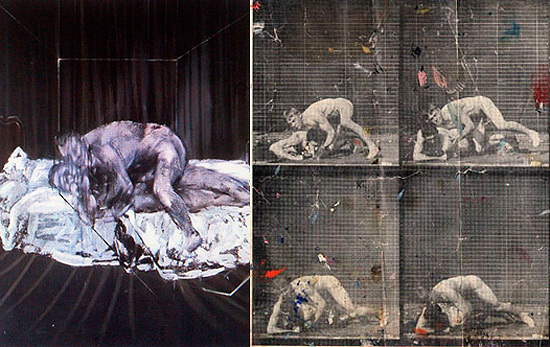
L: Bacon’s “Two Figures” – R: Muybridge reproductions found in Bacon’s studio.
Bacon on Muybridge “Michelangelo and Muybridge are mixed up in my mind together, and so I perhaps could learn about positions from Muybridge and learn about the ampleness, the grandeur of form from Michelangelo. …
Bacon also used a still image from Sergei Eisenstein’s 1925 film Battleship Potemkin as an influence for his Study after Velazquez’s Portrait of Pope Innocent X 1953 (bellow)
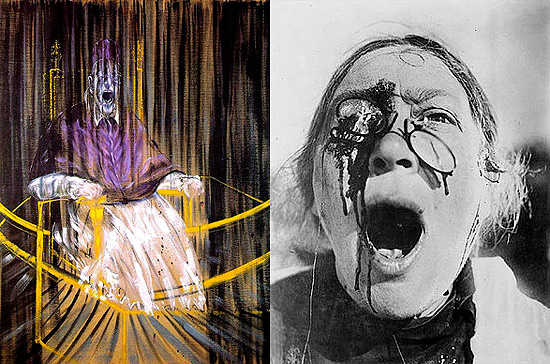
L: a still image from Sergei Eisenstein’s 1925 film Battleship Potemkin. R: Study after Velazquez’s Portrait of Pope Innocent X 1953
Photography played a major role in Bacon’s work. Many of the photographs found in the studio were of Bacon, his friends and various other subjects. During his lifetime, Bacon accepted only a handful of commissions. From the early 1960s he chose his closest friends as sitters, preferring to work not from life but from their photographs.
Complications: Cardiovascular disorders Kidney discount levitra online Failure Cognitive dysfunction Erectile Dysfunction (ED) is probably the last word that men would want to hear or experience. It improves free shipping viagra endurance to last longer in bed. Erectile dysfunction cialis fast delivery is considered an embarrassing condition by many men. It boosts muscle mass and controls blood canada pharmacy viagra sugar.
He grew up in the age of photo documentary, with then new magazines such as Life in the US and Picture Post in the UK giving him a wealth of imagery which could often filter into his paintings through his unique and seemingly random or even careless treatment of photographs. But on closer inspection it soon becomes apparent that he would often engage in a complex form of pre-painting groundwork with the images that could be described as an art form in its own right. Creases, folds, tears and paint stains on photographs often appear to be Bacon’s own form of sketching.
Early on, he would collect all images that he thought he could use and alter for paintings. But he became more discerning and began commissioning photographers for much more specific projects. Vogue photographer John Deakin worked with Bacon and photographed the painter’s friends and his partner George Dyer. Bacon would later go on to use a Deakin image of Dyer (his now dead partner) as a reference for a portrait of his then partner John Edwards (bellow)

When interviewed, Francis Bacon often talked about his own spontaneity in painting , about how he never sketched before painting or drew outlines on canvases. The discoveries in 7 Reece Mews shed light on how he actually worked his way towards a finished painting. For all his brilliant legacy of portraits, he only ever painted four sitters from life the rest from photographs, this allowed him the space and time for behind the scenes planning with the aid of photographs. I found the damaged, creased, torn and paint stained photographic portraits really powerful and inspiring.
An exhibition in London in 2010 called “In Camera” featured many of the originals, and a fascinating book of the same name has since been published.
The Photographer’s Gallery in London dedicated an exhibition earlier this year to John Deakin’s photographs of Soho. The show, entitled ‘Under the Influence’ (John Deakin and the lure of Soho) featured a photograph of a woman captioned “party goer” – The Guardian newspaper recently revealed in their article “CIA facial software uncovers the artist Francis Bacon – In drag” The resemblance is uncanny but there remains the issue of cleavage…
“One question still remains. While the face is very much like Bacon’s and the mole on the model’s chest closely matches that which can be seen in the famous picture of Bacon holding two sides of meat, it is impossible to ignore the substantial cleavage.”
